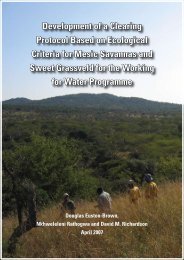Metsi Consultants - DWA Home Page
Metsi Consultants - DWA Home Page
Metsi Consultants - DWA Home Page
You also want an ePaper? Increase the reach of your titles
YUMPU automatically turns print PDFs into web optimized ePapers that Google loves.
Report No 678-F-001<br />
METSI CONSULTANTS: SUMMARY OF MAIN FINDINGS FOR PHASE 1 DEVELOPMENT<br />
areas and over-utilisation is regarded as a major threat to species survival. Compensation measures through the<br />
artificial propagation of selected species in the upstream catchment areas are intended to supply the market and<br />
relieve pressure on wild-grown plants. Such cultivation has yet to be proven to be effective and, even if this is the<br />
case, production of the full range of medicinal plants used by local people will hardly ever be practically possible.<br />
In the downstream areas the long-term survival of medicinal plant species is not as great a concern because of<br />
the linear nature of the area under impact and the availability of similar habitats along tributaries. The main<br />
objective downstream would be to compensate local users.<br />
Replacement of herbal medicines by synthetics will unlikely ever be total, and medicinal plants are in demand<br />
even in urban centres such as Maseru. However, the experience of the public health compensation programme in<br />
Phase 1A indicates that local people will make use of modern clinical facilities if they are available. Hence,<br />
provision of adequate community public health would be partial compensation for lost medicinal plant resources.<br />
11.4.3 Trees and Shrubs<br />
The field studies undertaken suggested that annual tree harvests, mainly poplar and willow branches, within the<br />
study zones on either side of the rivers downstream of the LHWP structures amounted to about 37,000. Flow<br />
regulation via the Treaty stipulations would reduce this number by approximately 25%. Releasing additional water<br />
would lead to reductions in these impacts but could not eliminate them because of the location of the trees on the<br />
upper benches of the river channel.<br />
A community forestry programme has been in operation in Phase 1A of the LHWP for the past five years, set up<br />
and run by an international NGO as a compensation measure for tree losses in the reservoir catchment. A<br />
170,000 seedling capacity nursery near Ha Lejone provides mainly hardy conifers for outplanting in villages. NGO<br />
staff provide advisory and extension services. Extension of the programme to areas downstream of the LHWP<br />
structures would be practical in terms of availability of expertise and local experience. Planting timber trees within<br />
actual village areas could not only potentially replace lost timber resources but would have the added advantages<br />
of providing easier access to the trees and the supplementary benefits of shade and windbreaks. Quite significant<br />
disadvantages would however be the extensive areas embraced by the downstream river reaches, the scattered<br />
nature of the villages and the lack of vehicle access to many parts.<br />
Shrubs, tree branches, dead wood and other debris make up the bulk of the woody material harvested by local<br />
people along the downstream reaches, and could be as much as 15,000 - 20,000 tonnes annually, depending on<br />
how the field data are interpreted. This represents the bulk of the energy used by these communities for cooking<br />
and heating. About half of this material would be lost to communities following Treaty flow reductions and, as in<br />
the case of timber, substantial increases in flows would be required to reduce the shortfall. This material would<br />
only partially be replaced by woodlot material from community forestry programmes. Adequate compensation of<br />
the energy value of gathered woody biomass would require much more ambitious tree plantings than currently<br />
applied in the reservoir areas or, alternately, might necessitate a technological leap to energy sources such as<br />
solar-powered cookers. Alternatively, or in addition to this, some of the losses could be off-set by a change in the<br />
method of collection of wood, particularly willows. At present, small branches stripped off the trees during wood<br />
collection are left on the banks; if these were thrown into the rivers, some would take root on banks of the<br />
downstream river<br />
64

















